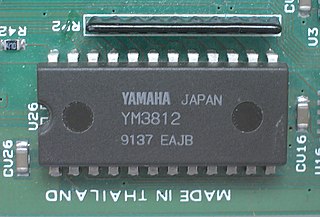
Ad Lib, Inc. was a Canadian manufacturer of sound cards and other computer equipment founded by Martin Prevel, a former professor of music and vice-dean of the music department at the Université Laval. The company's best known product, the AdLib Music Synthesizer Card (ALMSC), or simply the AdLib as it was called, was the first add-on sound card to achieve widespread game-developer acceptance, becoming the first de facto standard for audio reproduction.
Dolby Digital is the name for audio compression technologies developed by Dolby Laboratories. Originally named Dolby Stereo Digital until 1994, except for Dolby TrueHD, the audio compression is lossy. The first use of Dolby Digital was to provide digital sound in cinemas from 35mm film prints; today, it is now also used for other applications such as TV broadcast, radio broadcast via satellite, digital video streaming, DVDs, Blu-ray discs and game consoles.
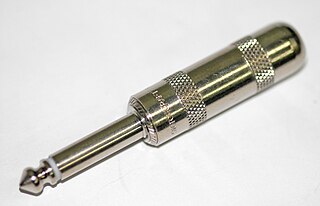
A phone connector, also known as phone jack, audio jack, headphone jack or jack plug, is a family of electrical connectors typically used for analog audio signals.

Monaural or monophonic sound reproduction is sound intended to be heard as if it were emanating from one position. This contrasts with stereophonic sound or stereo, which uses two separate audio channels to reproduce sound from two microphones on the right and left side, which is reproduced with two separate loudspeakers to give a sense of the direction of sound sources. In mono, only one loudspeaker is necessary, but, when played through multiple loudspeakers or headphones, identical signals are fed to each speaker, resulting in the perception of one-channel sound "imaging" in one sonic space between the speakers. Monaural recordings, like stereo ones, typically use multiple microphones fed into multiple channels on a recording console, but each channel is "panned" to the center. In the final stage, the various center-panned signal paths are usually mixed down to two identical tracks, which, because they are identical, are perceived upon playback as representing a single unified signal at a single place in the soundstage. In some cases, multitrack sources are mixed to a one-track tape, thus becoming one signal. In the mastering stage, particularly in the days of mono records, the one- or two-track mono master tape was then transferred to a one-track lathe intended to be used in the pressing of a monophonic record. Today, however, monaural recordings are usually mastered to be played on stereo and multi-track formats, yet retain their center-panned mono soundstage characteristics.

The Multimedia PC (MPC) was a recommended configuration for a personal computer (PC) with a CD-ROM drive. The standard was set and named by the "Multimedia PC Marketing Council", which was a working group of the Software Publishers Association. The MPMC comprised companies including Microsoft, Creative Labs, Dell, Gateway, and Fujitsu. Any PC with the required standards could be called an "MPC" by licensing the use of the logo from the SPA.

The Covox Speech Thing is an external audio device attached to the computer to output digital sound. It was composed of the most primitive 8-bit DAC using a resistor ladder and an analogue signal output, and plugged into the printer port of the PC.

The Ensoniq AudioPCI is a PCI-based sound card released in 1997. It was Ensoniq's last sound card product before they were acquired by Creative Technology. The card represented a shift in Ensoniq's market positioning. Whereas the Soundscape line had been made up primarily of low-volume high-end products full of features, the AudioPCI was designed to be a very simple, low-cost product to appeal to system OEMs and thus hopefully sell in mass quantities.
Sound Blaster Live! is a PCI add-on sound card from Creative Technology Limited for PCs. Moving from ISA to PCI allowed the card to dispense with onboard memory, storing digital samples in the computer's main memory and then accessing them in real time over the bus. This allowed for a much wider selection of, and longer playing, samples. It also included higher quality sound output at all levels, quadrophonic output, and a new MIDI synthesizer with 64 sampled voices. The Live! was introduced in August 1998 and variations on the design remained Creative's primary sound card line into the 2000s.

Sound Blaster Audigy is a product line of sound cards from Creative Technology. The flagship model of the Audigy family used the EMU10K2 audio DSP, an improved version of the SB-Live's EMU10K1, while the value/SE editions were built with a less-expensive audio controller.

The NeXT MegaPixel Display was a range of CRT-based computer monitors manufactured and sold by NeXT for the NeXTcube and NeXTstation workstations, designed by Hartmut Esslinger/Frog Design Inc.
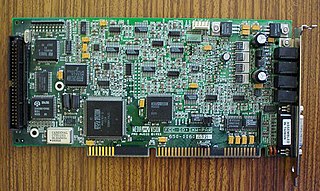
The Media Vision Pro AudioSpectrum family of personal computer sound cards included the original 8-bit Pro AudioSpectrum (1991), the 8-bit Pro AudioSpectrum Plus, 16-bit Pro AudioSpectrum 16, Pro AudioSpectrum 16 Basic and 16-bit Pro Audio Studio. All PAS cards with the exception of Pro AudioSpectrum 16 Basic could connect to CD-ROM drives—variants having SCSI or various proprietary interfaces—and many were sold in multimedia kits with compatible CD-ROM drives.
Sonar is a digital audio workstation created by Cakewalk.
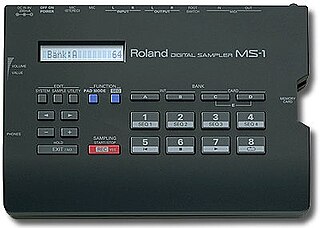
The Roland MS-1 Digital Sampler was a compact, 16-bit digital audio phrase sampler produced by Roland in 1994 as a straightforward, inexpensive, entry-level sampler.
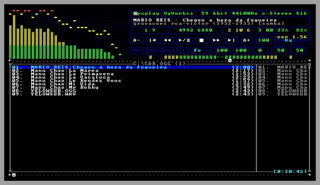
Mpxplay is a 32-bit console audio player for MS-DOS and Windows. It supports a wide range of audio codecs, playlists, as well as containers for video formats. The MS-DOS version uses a 32-bit DOS extender.
The ATi Wonder series represents some of the first graphics add on products for IBM PCs and compatibles introduced by ATi Technologies in the mid to late 1980s. These cards were unique at the time as they offered the end user a considerable amount of value by combining support for multiple graphics standards into a single card. The VGA Wonder series added additional value with the inclusion of a bus mouse port, which normally required the installation of a dedicated Microsoft Bus Mouse adapter.
The VIDC20 was a Video Display Controller chip created as an accompanying chip to the ARM CPU as used in RiscPC computer systems.

The Yamaha DX21 is a digital bi-timbral programmable algorithm synthesizer with a four operator synth voice generator which was released in 1985. It uses sine wave-based Frequency Modulation (FM) synthesis. It has two FM tone generators and a 32-voice Random Access Memory (RAM), 32 user voices and 128 Read Only Memory (ROM) factory preset sounds. As a programmable synth, it enables users to create their own unique synthesized tones and sound effects by using the algorithms and oscillators. The instrument weighs 8 kg. On its release, it sold for $795.




